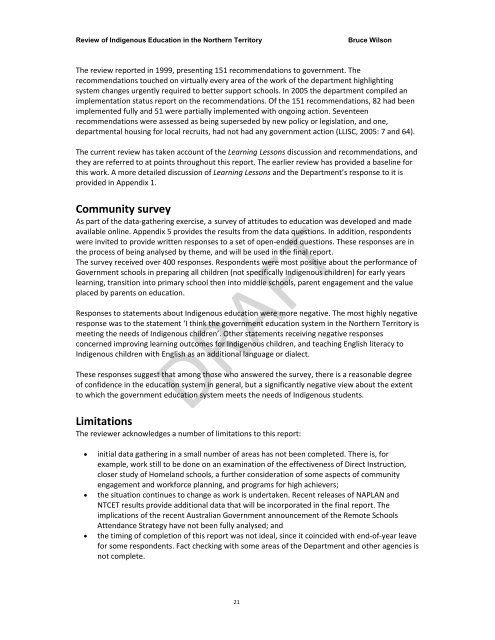Indigenous-Education-Review_DRAFT
Indigenous-Education-Review_DRAFT
Indigenous-Education-Review_DRAFT
Create successful ePaper yourself
Turn your PDF publications into a flip-book with our unique Google optimized e-Paper software.
<strong>Review</strong> of <strong>Indigenous</strong> <strong>Education</strong> in the Northern Territory<br />
Bruce Wilson<br />
The review reported in 1999, presenting 151 recommendations to government. The<br />
recommendations touched on virtually every area of the work of the department highlighting<br />
system changes urgently required to better support schools. In 2005 the department compiled an<br />
implementation status report on the recommendations. Of the 151 recommendations, 82 had been<br />
implemented fully and 51 were partially implemented with ongoing action. Seventeen<br />
recommendations were assessed as being superseded by new policy or legislation, and one,<br />
departmental housing for local recruits, had not had any government action (LLISC, 2005: 7 and 64).<br />
The current review has taken account of the Learning Lessons discussion and recommendations, and<br />
they are referred to at points throughout this report. The earlier review has provided a baseline for<br />
this work. A more detailed discussion of Learning Lessons and the Department’s response to it is<br />
provided in Appendix 1.<br />
Community survey<br />
As part of the data‐gathering exercise, a survey of attitudes to education was developed and made<br />
available online. Appendix 5 provides the results from the data questions. In addition, respondents<br />
were invited to provide written responses to a set of open‐ended questions. These responses are in<br />
the process of being analysed by theme, and will be used in the final report.<br />
The survey received over 400 responses. Respondents were most positive about the performance of<br />
Government schools in preparing all children (not specifically <strong>Indigenous</strong> children) for early years<br />
learning, transition into primary school then into middle schools, parent engagement and the value<br />
placed by parents on education.<br />
Responses to statements about <strong>Indigenous</strong> education were more negative. The most highly negative<br />
response was to the statement ‘I think the government education system in the Northern Territory is<br />
meeting the needs of <strong>Indigenous</strong> children’. Other statements receiving negative responses<br />
concerned improving learning outcomes for <strong>Indigenous</strong> children, and teaching English literacy to<br />
<strong>Indigenous</strong> children with English as an additional language or dialect.<br />
<strong>DRAFT</strong><br />
These responses suggest that among those who answered the survey, there is a reasonable degree<br />
of confidence in the education system in general, but a significantly negative view about the extent<br />
to which the government education system meets the needs of <strong>Indigenous</strong> students.<br />
Limitations<br />
The reviewer acknowledges a number of limitations to this report:<br />
<br />
<br />
<br />
initial data gathering in a small number of areas has not been completed. There is, for<br />
example, work still to be done on an examination of the effectiveness of Direct Instruction,<br />
closer study of Homeland schools, a further consideration of some aspects of community<br />
engagement and workforce planning, and programs for high achievers;<br />
the situation continues to change as work is undertaken. Recent releases of NAPLAN and<br />
NTCET results provide additional data that will be incorporated in the final report. The<br />
implications of the recent Australian Government announcement of the Remote Schools<br />
Attendance Strategy have not been fully analysed; and<br />
the timing of completion of this report was not ideal, since it coincided with end‐of‐year leave<br />
for some respondents. Fact checking with some areas of the Department and other agencies is<br />
not complete.<br />
21


